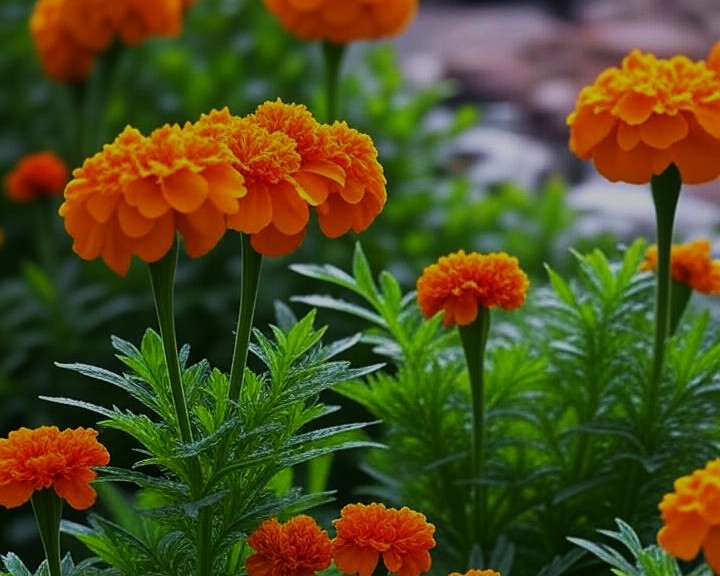Many gardeners think the planting season ends in spring, but mid-summer actually offers wonderful opportunities to add vibrant color to your New Jersey garden. Whether you’re looking to fill bare spots, replace tired spring flowers, or simply extend your garden’s beauty into fall, June and July are perfect months for strategic planting.
The key to successful mid-summer gardening lies in choosing flowers that not only tolerate the heat but actually thrive in it. Many of these selections will reward you with blooms that last well into autumn, providing months of enjoyment with relatively little effort.
Foolproof Annual Flowers for Instant Color
For immediate impact and season-long color, few flowers match the reliability of zinnias. These cheerful annuals come in nearly every color except blue and grow quickly from either seeds or transplants. Once established, they’re remarkably drought-tolerant and will bloom continuously until the first frost. Their sturdy stems make them excellent for cutting gardens too.
Marigolds deserve their reputation as garden workhorses, particularly the French and smaller signet varieties. These sunny flowers require minimal care once planted and their pest-deterrent properties make them valuable companion plants throughout the garden. Unlike their larger African cousins, French marigolds handle mid-summer transplanting beautifully.
For vertical interest and pollinator appeal, consider morning glories. These fast-growing vines can still be sown from seed in June and will quickly cover fences, trellises, or arbors. Their trumpet-shaped blooms open each morning in shades of blue, purple, pink, or white, attracting both hummingbirds and butterflies.
Perennial Powerhouses for Long-Term Beauty
The real stars of mid-summer planting are the perennials that establish quickly and provide years of reliable blooms. Black-eyed Susans are perhaps the most dependable choice for New Jersey gardens. These golden-yellow flowers with dark centers are virtually foolproof, thriving in various soil conditions and blooming from June through September. They’re also magnets for beneficial pollinators.
Purple coneflowers (Echinacea) offer similar reliability with their distinctive daisy-like blooms and prominent central cones. Available in the traditional purple as well as newer varieties in white, pink, and coral, these plants adapt to both sun and partial shade while attracting bees and butterflies. As an added bonus, their seed heads provide winter interest and food for birds.
For late-season drama, asters are unmatched. These fall-blooming perennials come in various heights and flower colors, from compact border varieties to tall specimens perfect for garden backgrounds. Their drought tolerance makes them particularly valuable during hot, dry summers.
Show-Stopping Specialty Flowers
Hibiscus, particularly the hardy Rose Mallow varieties, bring tropical flair to New Jersey gardens with their dinner-plate-sized blooms. Varieties like ‘Kopper King’ combine large red flowers with burgundy foliage for stunning contrast. While they may seem exotic, these plants are surprisingly hardy and well-suited to our climate.
Dahlias planted in mid-summer will peak just as other flowers begin to fade. These magnificent flowers come in countless forms and colors, from tiny pompoms to massive dinner-plate varieties. They’re particularly rewarding for gardeners who enjoy more hands-on care, as they benefit from regular watering and feeding.
Low-Maintenance Perennial Gems
For gardeners seeking maximum impact with minimal effort, several perennials stand out. Russian sage produces clouds of purple-blue flowers from July through October while tolerating drought and poor soil. Its aromatic foliage adds another sensory dimension to the garden.
Blanket flowers (Gaillardia) offer warm-toned, daisy-like blooms in combinations of red, orange, and yellow. These tough plants are deer-resistant and bloom continuously with minimal care. Similarly, butterfly weed provides brilliant orange flowers while being both drought-tolerant and a crucial food source for monarch butterflies.
Success Tips for Mid-Summer Planting
Mid-summer planting requires extra attention to watering, especially during the first few weeks. Water new transplants deeply and regularly until you see signs of new growth, indicating they’ve established their root systems. Early morning watering is most effective and helps prevent fungal diseases.
Mulching is particularly important for summer plantings. A two-to-three-inch layer of organic mulch around new plants helps retain soil moisture, suppress weeds, and keep roots cool during hot spells. Good mulch choices include shredded hardwood, pine needles, or composted leaves.
Consider your garden’s specific conditions when selecting plants. While most of these flowers prefer full sun, options like coral bells, great blue lobelia, and some varieties of purple coneflower will tolerate partial shade. Similarly, if your soil tends to be dry, focus on drought-tolerant choices like Russian sage, blanket flower, and butterfly weed.
Planning for Seasonal Succession
The beauty of mid-summer planting lies in creating layers of bloom that carry your garden through multiple seasons. Early summer flowers like daylilies and catmint can be paired with later-blooming asters and Russian sage for continuous color. This approach ensures your garden remains vibrant even as temperatures begin to cool.
Mid-summer is also an excellent time to establish plants that will naturalize and return each year with minimal intervention. Black-eyed Susans, purple coneflowers, and asters will often self-seed, gradually expanding their presence in your garden while providing food and habitat for wildlife.
With thoughtful plant selection and proper care, your mid-summer garden additions will provide months of beauty and satisfaction. These reliable performers prove that the gardening season extends well beyond spring, offering endless opportunities to create and maintain a landscape that brings joy throughout the growing season and beyond.


